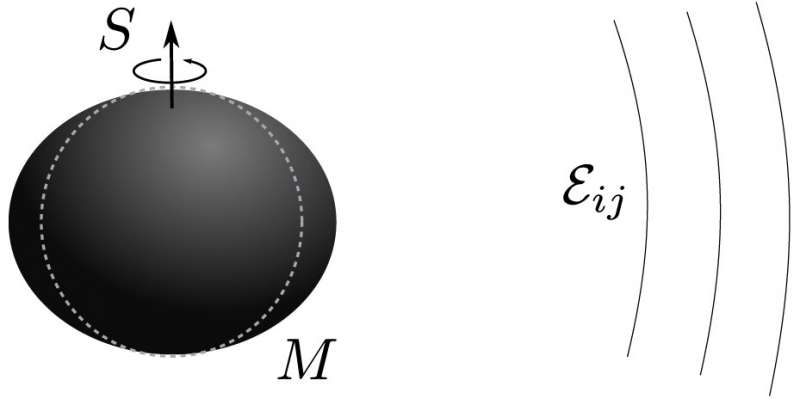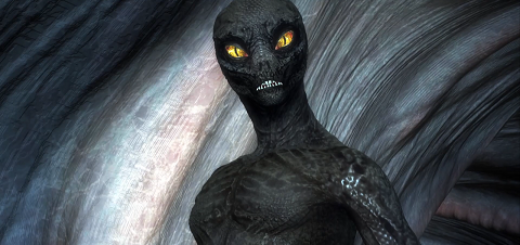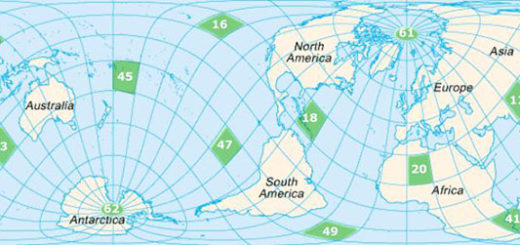Spinning black holes could deform under an external and static gravitational field

An open question among the physics community is whether black holes can be tidally deformed by an external gravitational field. If this were confirmed to be true, it could have important implications for many areas of physics, including fundamental physics, astrophysics and gravitational-wave astronomy.
Researchers at Observatoire de Paris- CNRS and Centro Brasileiro de Pesquisas Fisicas (CBPF) recently carried out a study investigating the tidal deformability of black holes under an external, static gravitational field. Their paper, published in Physical Review Letters, suggests that under such a field, spinning black holes could generally deform.
“The idea for this work partly arose from a couple of talks during the International Conference on General Relativity and Gravitation (GR22) in 2019,” Marc Casals, one of the researchers who carried out the study, told Phys.org. “During these talks, the speakers discussed the deformability of neutron stars due to an external gravitational tidal field. They also mentioned that, contrarily to neutron stars, the (static) tidal deformability of non-rotating black holes is zero, as shown by several studies. This result immediately begged the question of whether the (static) tidal deformability of rotating black holes is also zero.”
The deformability of rotating black holes under a static gravitational field had already been investigated by a team of researchers at Sapienza University of Rome. In a paper published in 2015, these researchers showed that when the static tidal field is symmetric with respect to a black hole’s axis of rotation, the black hole’s deformability is zero.
In their study, Casals and his colleague Alexandre Le Tiec wanted to investigate the deformability of rotating black holes when the tidal field applied to them is arbitrary (i.e., not necessarily axi-symmetric). This is a particularly important question, as all astrophysical black holes are believed to be rotating; thus, any external tidal fields would typically not be axi-symmetric.
“Past papers gave us some clues as to what methods to use,” Casals explained. “One of them was a specific mathematical technique: Letting the so-called multipolar index temporarily take on real numbers, whereas its physical values are meant to be purely integer numbers (e.g., 2, 3, 4, …).”
The mathematical technique used by Casals and Le Tiec can be used to disentangle the tidal deformation of a black hole from the external tidal field that caused it, in order to then set the multipolar index to be a physical integer number. Despite its advantages, however, this technique is probably difficult to use directly on equations that are satisfied by the gravitational field itself.
“Instead, we applied it first to another quantity, which involves derivatives of the gravitational field (it essentially measures the curvature of the spacetime) and, crucially, satisfies a simpler equation which was derived in a past paper by S. Teukolsky,” Casals said. “From this quantity, we can then obtain the gravitational field.”
The measurement of a gravitational field depends on who its ‘observer’ is, or, in mathematical terms, on the coordinate system. Therefore, as a final step, Casals and Le Tiec built quantities that are independent of the observer (or coordinates), so that they could identify the tidal deformability of rotating black holes in a way that was truly meaningful.
“These observer-independent quantities are the so-called Geroch-Hansen multipole moments, named after the authors who came up with them (namely, R. P. Geroch in 1970 and R.O. Hansen in 1974),” Casals said.
Overall, the calculations carried out by this team of researchers show that rotating black holes generically deform under an external and static gravitational field. This result is in stark contrast with past study findings related to non-rotating black holes or rotating black holes with an axi-symmetric tidal field.
“We calculated this deformation explicitly for the case of a weak tidal field with multipolar index equal to 2 and for small black hole rotation,” Casals said. “Furthermore, we linked this tidal deformation to the previously known effect of tidal torquing; a change in the angular momentum of the black hole due to the tidal field.”
The findings gathered by Casals and Le Tiec could pave the way for more studies investigating the deformability of spinning black holes under a static tidal field. In their paper, the researchers also speculate on the possibility that such a tidal deformation could be observed within the gravitational waves expected to be detected by the Laser Interferometer Space Antenna (LISA) mission, which is planned for 2034.
“Our research can naturally be extended in a number of directions,” Alexandre Le Tiec told Phys.org. “We could, for instance, investigate the tidal deformability of spinning black holes: (i) for multipolar index higher than 2; (ii) for large black hole rotation; or (iii) for a strong tidal field. It would also be interesting to explore the precise link between tidal deformability, tidal heating and the nonzero viscosity of the event horizon of black holes within the so-called membrane paradigm.”



 Creators of mankind
Creators of mankind Description of “Tall white aliens”
Description of “Tall white aliens” Where they came from?
Where they came from? About hostile civilizations
About hostile civilizations The war for the Earth
The war for the Earth “Tall white aliens” about eternal life
“Tall white aliens” about eternal life Video: “Nordic aliens”
Video: “Nordic aliens” Aliens
Aliens Alien encounters
Alien encounters The aliens base
The aliens base UFO
UFO Technology UFO
Technology UFO Underground civilization
Underground civilization Ancient alien artifacts
Ancient alien artifacts Military and UFO
Military and UFO Mysteries and hypotheses
Mysteries and hypotheses Scientific facts
Scientific facts


















